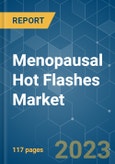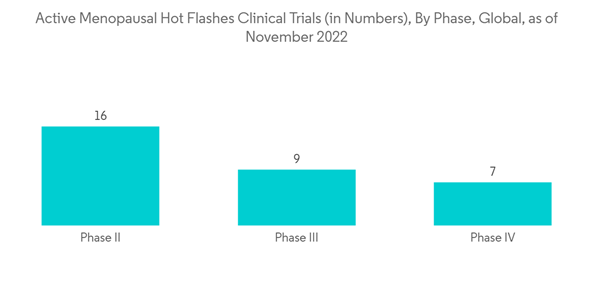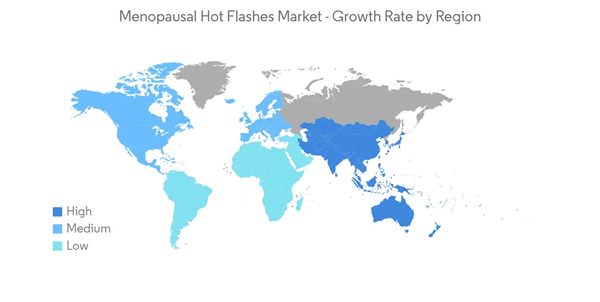The menopausal hot flashes market is projected to register a CAGR of 3.4% during the forecast period.
The COVID-19 pandemic has posed severe challenges to healthcare systems and has drastically cut down in- and outpatient services in hospitals and clinics. The lockdown measures and restrictions imposed by the government have impacted the lives of patients suffering from menopausal symptoms. For instance, per an article published in Women and Health in May 2021, women suffering from the uncomfortable symptoms of perimenopause, such as vasomotor symptoms (VMS), have had trouble finding doctors and procuring menopausal hormonal therapy. This has impacted the demand for menopausal drugs and therapies, slowing the market growth. However, with the released COVID restrictions and resumed treatment services, the studied market is expected to recover from the decline of the COVID-19 pandemic in the next two-three years.
The factors such as the rising incidence of menopausal vasomotor symptoms and technological advancements in developing new drugs for treatment are boosting the market growth. For instance, as per an article published in Women's Health in June 2022, an online survey was conducted in the United Kingdom from 19 May 2021 to 26 May 2021 to evaluate attitudes, knowledge, and symptoms experienced by women during menopause in women older than 40 years. It has been observed that 68.9% of the women experienced mood swings, 68.3% experienced brain fog, and 66.8% experienced fatigue symptoms during their menopause stage. In addition, other psychological issues, including irritability, poor concentration, poor memory, lack of motivation, reduced confidence, and anxiety, affect their quality of life. This is expected to increase the demand for effective drugs and hormonal therapies to relieve these symptoms, propelling the market growth.
Additionally, as per an article published in the International Journal of Reproductive BioMedicine in September 2021, it has been observed that about 50-85% of women experience hot menopausal symptoms globally. In addition, as per the same source, the highest prevalence of menopausal hot flashes symptoms was reported in Western countries and the lowest in Asia. This is expected to fuel the demand for hormonal as well as non-hormonal therapies for treating menopausal symptoms, hence bolstering the market growth.
Similarly, as per a study published in NCBI in December 2021, hot flashes were among the most common types of menopausal vasomotor (VMS) symptoms, affecting up to 74% of perimenopausal women. About 65% of women complain of hot flashes for more than two years, and 36% cry for more than five years. Therefore, the increasing incidence of menopausal vasomotor symptoms is a significant factor contributing to the market growth of menopausal hot flashes.
Furthermore, the increasing focus on research for the development of treatment of hot flashes is also propelling the market's growth. For Instance, in June 2022, Astellas Pharma Inc. submitted a New Drug Application (NDA) for fezolinetant to the United States Food and Drug Administration. Fezolinetant is an investigational oral, non-hormonal compound seeking approval to treat moderate to severe vasomotor symptoms (VMS) associated with menopause. Also, in October 2021, Bayer commenced the Phase III clinical development program OASIS to evaluate the efficacy and safety of elinzanetant, a first-in-class, non-hormonal, once-daily, oral, dual neurokinin-1,3 receptor antagonist, for the treatment of vasomotor symptoms during menopause.
Moreover, in February 2021, Astellas Pharma Inc. reported positive results from the Phase III study of pivotal SKYLIGHT 1 and SKYLIGHT 2 (fezolinetant), an oral, non-hormonal compound being evaluated for the treatment of moderate to severe vasomotor symptoms (VMS) and hot flashes.
Thus, owing to the factors mentioned earlier, such as the high prevalence of hot flashes, increasing research and development studies are expected to drive the market's growth over the forecast period. However, the side effects associated with hormonal products and the availability of generic medicines are expected to hinder the development of the menopausal hot flashes market over the forecast period.
Estrogen supplements help increase female hormone levels and reduce the symptoms of menopause, including fever. Some of the United States FDA-approved estradiol-containing heat treatments are Alora, Estraderm, Estrogel, Evamist, Vivelle, Climara, Divigel, and Estrace. Some of the benefits associated with estrogen medications include improving the health of the vagina, reducing the symptoms of menopause, and possibly promoting bone and heart health.
The rising burden of menopausal vasomotor symptoms is the key factor driving the demand for hormonal therapy. As per an article published in Frontiers in Endocrinology in March 2021, it was observed that systemic estrogen therapy is the most effective treatment for the relief of troublesome menopausal hot flashes and night sweats. Additionally, it can lessen menopausal vaginal symptoms, such as dryness, itching, burning, and discomfort during sexual activity, as well as vulvovaginal atrophy, including vaginal dryness and dyspareunia. As a result, the estrogen component is essential in the market for menopausal hot flashes and is predicted to exhibit a similar trend during the projected period.
Therefore, due to the high prevalence of menopausal symptoms and the availability of estradiol drugs and related products, the studied segment is expected to grow over the forecast period.
According to an article published in the Journal of the North American Menopause Society in August 2021, it has been observed that the prevalence of vasomotor menopausal symptoms was high in the United States. As per the same source, the most common menopausal symptoms were feeling tired or worn out, pain in muscles and joints, difficulty sleeping, and hot flashes. The menopausal hot flashes and night sweats had a more considerable influence on daily activities than on work-related activities. Thus, the high burden of menopausal vasomotor symptoms among women is expected to increase the demand for effective treatment, propelling the market growth.
Additionally, the rising aging women population in the region increases the demand for menopausal drugs and therapies as they experience poor quality of life due to several symptoms during the menopause phase. For instance, as per a research report published by the Menopause Foundation of Canada, in October 2022, about 10 million women living in Canada over the age of 40 years were in their perimenopause, menopause, and postmenopause stage. It has been observed that 84% of the women experienced hot flashes, and 77% were aware of night sweats. In addition, more than two-thirds of the women population was unaware of additional symptoms such as urinary tract infections, heart palpitations, migraines, anxiety, depression, and memory issues.
The rising product launches and approvals from the regulatory authority, as well as growing company activities in conducting clinical trials for treating menopausal symptoms, are also propelling the market growth. As per clinicaltrials.gov, as of September 2022, Acer Therapeutics Inc. conducted a Phase II clinical study of ACER-801 (osanetant) to assess its safety and effectiveness in treating moderate to severe Vasomotor Symptoms (VMS). Also, in December 2021, Acer Therapeutics Inc. received United States FDA clearance of its Investigational New Drug (IND) application for its selective non-peptide neurokinin three receptors (NK3R) antagonist, ACER-801 (osanetant) for the potential treatment of induced Vasomotor Symptoms (iVMS).
Furthermore, in May 2021, TherapeuticsMD, Inc. submitted a supplemental New Drug Application for BIJUVA (estradiol and progesterone) capsules, 0.5 mg/100 mg, a hormone therapy combination of estradiol and progesterone in a single, oral capsule, to the United States FDA.
Thus, owing to the abovementioned factors, such as the high prevalence of vasomotor menopausal symptoms coupled with the aging women population and increasing product launches and company activities, the studied market is expected to grow in the North American region over the forecast period.
This product will be delivered within 2 business days.
The COVID-19 pandemic has posed severe challenges to healthcare systems and has drastically cut down in- and outpatient services in hospitals and clinics. The lockdown measures and restrictions imposed by the government have impacted the lives of patients suffering from menopausal symptoms. For instance, per an article published in Women and Health in May 2021, women suffering from the uncomfortable symptoms of perimenopause, such as vasomotor symptoms (VMS), have had trouble finding doctors and procuring menopausal hormonal therapy. This has impacted the demand for menopausal drugs and therapies, slowing the market growth. However, with the released COVID restrictions and resumed treatment services, the studied market is expected to recover from the decline of the COVID-19 pandemic in the next two-three years.
The factors such as the rising incidence of menopausal vasomotor symptoms and technological advancements in developing new drugs for treatment are boosting the market growth. For instance, as per an article published in Women's Health in June 2022, an online survey was conducted in the United Kingdom from 19 May 2021 to 26 May 2021 to evaluate attitudes, knowledge, and symptoms experienced by women during menopause in women older than 40 years. It has been observed that 68.9% of the women experienced mood swings, 68.3% experienced brain fog, and 66.8% experienced fatigue symptoms during their menopause stage. In addition, other psychological issues, including irritability, poor concentration, poor memory, lack of motivation, reduced confidence, and anxiety, affect their quality of life. This is expected to increase the demand for effective drugs and hormonal therapies to relieve these symptoms, propelling the market growth.
Additionally, as per an article published in the International Journal of Reproductive BioMedicine in September 2021, it has been observed that about 50-85% of women experience hot menopausal symptoms globally. In addition, as per the same source, the highest prevalence of menopausal hot flashes symptoms was reported in Western countries and the lowest in Asia. This is expected to fuel the demand for hormonal as well as non-hormonal therapies for treating menopausal symptoms, hence bolstering the market growth.
Similarly, as per a study published in NCBI in December 2021, hot flashes were among the most common types of menopausal vasomotor (VMS) symptoms, affecting up to 74% of perimenopausal women. About 65% of women complain of hot flashes for more than two years, and 36% cry for more than five years. Therefore, the increasing incidence of menopausal vasomotor symptoms is a significant factor contributing to the market growth of menopausal hot flashes.
Furthermore, the increasing focus on research for the development of treatment of hot flashes is also propelling the market's growth. For Instance, in June 2022, Astellas Pharma Inc. submitted a New Drug Application (NDA) for fezolinetant to the United States Food and Drug Administration. Fezolinetant is an investigational oral, non-hormonal compound seeking approval to treat moderate to severe vasomotor symptoms (VMS) associated with menopause. Also, in October 2021, Bayer commenced the Phase III clinical development program OASIS to evaluate the efficacy and safety of elinzanetant, a first-in-class, non-hormonal, once-daily, oral, dual neurokinin-1,3 receptor antagonist, for the treatment of vasomotor symptoms during menopause.
Moreover, in February 2021, Astellas Pharma Inc. reported positive results from the Phase III study of pivotal SKYLIGHT 1 and SKYLIGHT 2 (fezolinetant), an oral, non-hormonal compound being evaluated for the treatment of moderate to severe vasomotor symptoms (VMS) and hot flashes.
Thus, owing to the factors mentioned earlier, such as the high prevalence of hot flashes, increasing research and development studies are expected to drive the market's growth over the forecast period. However, the side effects associated with hormonal products and the availability of generic medicines are expected to hinder the development of the menopausal hot flashes market over the forecast period.
Menopausal Hot Flashes Market Trends
Estrogen Segment Expected to Hold Significant Market Share
The estrogen segment is expected to witness significant growth in the overall market over the forecast period. The factors attributing to the market growth are the increasing aging women population along with the rising number of menopausal symptoms as well as increasing product launches.Estrogen supplements help increase female hormone levels and reduce the symptoms of menopause, including fever. Some of the United States FDA-approved estradiol-containing heat treatments are Alora, Estraderm, Estrogel, Evamist, Vivelle, Climara, Divigel, and Estrace. Some of the benefits associated with estrogen medications include improving the health of the vagina, reducing the symptoms of menopause, and possibly promoting bone and heart health.
The rising burden of menopausal vasomotor symptoms is the key factor driving the demand for hormonal therapy. As per an article published in Frontiers in Endocrinology in March 2021, it was observed that systemic estrogen therapy is the most effective treatment for the relief of troublesome menopausal hot flashes and night sweats. Additionally, it can lessen menopausal vaginal symptoms, such as dryness, itching, burning, and discomfort during sexual activity, as well as vulvovaginal atrophy, including vaginal dryness and dyspareunia. As a result, the estrogen component is essential in the market for menopausal hot flashes and is predicted to exhibit a similar trend during the projected period.
Therefore, due to the high prevalence of menopausal symptoms and the availability of estradiol drugs and related products, the studied segment is expected to grow over the forecast period.
North America Expected to Hold Significant Market Share
North America is expected to grow in the menopausal hot flashes market due to the increased incidence of menopause, increased awareness of menopause, rising healthcare expenditure, and a large percentage of older women in the region.According to an article published in the Journal of the North American Menopause Society in August 2021, it has been observed that the prevalence of vasomotor menopausal symptoms was high in the United States. As per the same source, the most common menopausal symptoms were feeling tired or worn out, pain in muscles and joints, difficulty sleeping, and hot flashes. The menopausal hot flashes and night sweats had a more considerable influence on daily activities than on work-related activities. Thus, the high burden of menopausal vasomotor symptoms among women is expected to increase the demand for effective treatment, propelling the market growth.
Additionally, the rising aging women population in the region increases the demand for menopausal drugs and therapies as they experience poor quality of life due to several symptoms during the menopause phase. For instance, as per a research report published by the Menopause Foundation of Canada, in October 2022, about 10 million women living in Canada over the age of 40 years were in their perimenopause, menopause, and postmenopause stage. It has been observed that 84% of the women experienced hot flashes, and 77% were aware of night sweats. In addition, more than two-thirds of the women population was unaware of additional symptoms such as urinary tract infections, heart palpitations, migraines, anxiety, depression, and memory issues.
The rising product launches and approvals from the regulatory authority, as well as growing company activities in conducting clinical trials for treating menopausal symptoms, are also propelling the market growth. As per clinicaltrials.gov, as of September 2022, Acer Therapeutics Inc. conducted a Phase II clinical study of ACER-801 (osanetant) to assess its safety and effectiveness in treating moderate to severe Vasomotor Symptoms (VMS). Also, in December 2021, Acer Therapeutics Inc. received United States FDA clearance of its Investigational New Drug (IND) application for its selective non-peptide neurokinin three receptors (NK3R) antagonist, ACER-801 (osanetant) for the potential treatment of induced Vasomotor Symptoms (iVMS).
Furthermore, in May 2021, TherapeuticsMD, Inc. submitted a supplemental New Drug Application for BIJUVA (estradiol and progesterone) capsules, 0.5 mg/100 mg, a hormone therapy combination of estradiol and progesterone in a single, oral capsule, to the United States FDA.
Thus, owing to the abovementioned factors, such as the high prevalence of vasomotor menopausal symptoms coupled with the aging women population and increasing product launches and company activities, the studied market is expected to grow in the North American region over the forecast period.
Menopausal Hot Flashes Market Competitor Analysis
The menopausal hot flashes market is fragmented, with the presence of several key players in the market. To withhold their market positions, the companies are focusing on adopting various key strategies, such as partnerships, collaboration, product launches, and others. Some of the companies currently dominating the market are AbbVie Inc. (Allergan PLC), Bayer AG, Novartis AG, Pfizer Inc., Novo Nordisk Corporation, Hisamitsu Pharmaceutical Co. Inc., Merck & Co. Inc., and Teva Pharmaceutical Industries Ltd.Additional benefits of purchasing the report:
- The market estimate (ME) sheet in Excel format
- 3 months of analyst support
This product will be delivered within 2 business days.
Table of Contents
1 INTRODUCTION
4 MARKET DYNAMICS
5 MARKET SEGMENTATION (Market Size by Value - USD Million)
6 COMPETITIVE LANDSCAPE
Companies Mentioned (Partial List)
A selection of companies mentioned in this report includes, but is not limited to:
- AbbVie Inc. (Allergan PLC)
- Bayer AG
- Novartis AG
- Pfizer Inc.
- Novo Nordisk Corporation
- Hisamitsu Pharmaceutical Co. Inc.
- Merck & Co. Inc.
- Teva Pharmaceutical Industries Ltd
- Agile Therapeutics
- Amgen Inc.
- AstraZeneca PLC
- Bristol-Myers Squibb Company
- Ferring BV
Methodology

LOADING...










